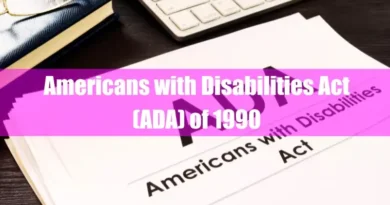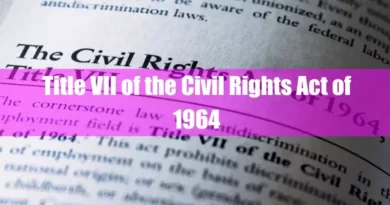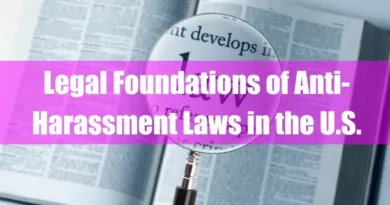Age Discrimination in Employment Act (ADEA) of 1967
Takeaways
| Key Points |
|---|
| The ADEA protects workers aged 40 and older from age-based discrimination in employment decisions (hiring, firing, promotions, compensation) and applies to both private and public employers, with private-sector coverage requiring at least 20 employees. |
| Certain exceptions exist under the ADEA, allowing mandatory retirement for high-level executives and policymakers with a substantial pension, as well as specific public safety roles (like firefighters) where age may be a legitimate occupational factor. |
| While age-based discrimination in benefits (like pensions and health insurance) is generally prohibited, employers can adjust benefits for older workers if they can prove higher costs, as long as these adjustments comply with ADEA regulations and don’t disproportionately harm older employees. |
| The ADEA is enforced by the EEOC, requiring employees to file complaints before pursuing legal action, with time limits for filing claims generally set at 180 days or up to 300 days in states with additional age discrimination laws. |
Introduction
The Age discrimination in Employment Act (ADEA), passed in 1967, is a U.S. law designed to protect workers aged 40 and older from discrimination in the workplace. It prohibits employers from making employment decisions such as hiring, firing, promotions, and compensation based on age. The law applies to private and public employers with 20 or more employees.
The ADEA prohibits age-based limitations in job advertisements and benefits but allows certain exceptions. These exceptions include situations where age is a bona fide occupational qualification (BFOQ) or for executives in high policy-making positions who may be subject to mandatory retirement if they are eligible for a substantial pension. The law is enforced by the Equal Employment Opportunity Commission (EEOC).
Key Provisions of the ADEA
The ADEA applies to private-sector employers with 20 or more employees, while it covers public-sector employers of any size. It prohibits the use of age as a determining factor in:
- Hiring or firing decisions: Employers cannot deny individuals employment based on age.
- Promotion and compensation: Age cannot be used to withhold promotions or reduce wages.
- Terms and conditions of employment: Work benefits, such as health insurance or pensions, cannot generally be reduced based on an employee’s age. However, the ADEA permits benefit reductions if an employer can prove that the cost of providing benefits to older workers is significantly higher than for younger workers, as allowed under the Older Workers Benefit Protection Act.
Additionally, the Act outlaws mandatory retirement for most professions, with some exceptions, such as specific executives and high-level employees who may have contracts that allow for retirement once they have reached a certain compensation threshold.
EEOC Enforcement and Reporting
The ADEA is enforced by the Equal Employment Opportunity Commission (EEOC). Employees who believe they have experienced age discrimination must first file a complaint with the EEOC before pursuing legal action. Typically, an employee has 180 days to file a claim, though this can be extended to 300 days in states with their own age discrimination laws.
Historical Context
At the time of the ADEA’s passage, age discrimination was pervasive. Many employers believed that older workers were less productive, more costly due to higher wages, and resistant to new technologies. These perceptions led to widespread discriminatory practices, particularly in industries facing modernization. The ADEA sought to level the playing field by ensuring that employment decisions were based on merit rather than age-related biases.
The original Act covered workers between 40 and 65 years of age. Subsequent amendments have removed the upper age limit and enhanced protections against benefit reductions based on age, including the Older Workers Benefit Protection Act of 1990, which prevents employers from forcing older workers to sign away their rights in exchange for benefits like severance pay.
Impact of the ADEA on the Labor Market
Research indicates that the ADEA has positively impacted the employment prospects of older workers, especially in states with strong age discrimination laws that mirror the ADEA. For example, studies suggest that states with such protections report higher employment rates for older workers compared to those without these laws. The ADEA has helped reduce instances of terminations and layoffs targeting older workers, though its effectiveness can fluctuate depending on economic conditions and other factors.
Despite these advances, subtle age discrimination persists, particularly in hiring. Studies show that older applicants still receive fewer interview callbacks than younger candidates. Proving age discrimination in hiring remains more challenging than termination cases, as hiring biases tend to be implicit and harder to identify.

Exceptions and Exemptions
While the ADEA offers broad protections against age discrimination, specific exceptions exist. Employers can enforce mandatory retirement for high-level executives (bona fide executives) and policymakers aged 65 or older if they are eligible for a pension of at least $44,000 annually.
Additionally, mandatory retirement for public safety employees, such as firefighters and law enforcement officers, may be subject to state laws but must meet the ‘bona fide occupational qualification’ (BFOQ) standard to ensure age is a legitimate factor for job performance.
Employers may adjust benefits for older employees if the cost of providing those benefits is higher due to age-related factors. However, these adjustments must comply with the ADEA, ensuring that they are justified by actual cost differences and are not used as a pretext for age discrimination. Any changes must not disproportionately impact older employees in a way that undermines their protections under the ADEA.

Challenges and Criticisms
The ADEA has faced various criticisms and legal challenges over time. Some argue that the ADEA could unintentionally discourage hiring older workers, as employers might be concerned about the risk of potential lawsuits. However, empirical evidence on this effect is inconclusive. While the ADEA has successfully reduced overt forms of age discrimination, many believe that more subtle forms of ageism, such as limited career advancement opportunities for older employees, still persist in workplaces.
Moreover, the process for bringing a lawsuit under the ADEA can be burdensome for employees. Before an employee can file a lawsuit, they must first go through the EEOC’s administrative procedures, which can be lengthy. This requirement can deter some workers from pursuing claims, particularly those seeking prompt resolutions to workplace disputes.

Amendments to the ADEA
Since its inception, the ADEA has been amended several times to strengthen its protections for older workers. In 1986, an amendment removed the upper age limit of 70, making it illegal for most employers to enforce mandatory age-based retirement. This change became particularly relevant as the workforce aged, with more individuals choosing or needing to remain employed beyond the traditional retirement age. While this shift highlights the growing importance of retirement flexibility, it is driven by various factors beyond just the ADEA, including longer life expectancy, evolving economic needs, and changes in social security policies.
The Older Workers Benefit Protection Act (OWBPA) of 1990 added further protections, specifically regarding pension plans and retirement benefits. It ensured that employees could not be forced to waive their right to sue for age discrimination in exchange for severance or retirement packages. Employers must now provide detailed information about the waiver process, allowing workers 21 days to review the offer and 7 days to revoke their decision after signing.

The Future of the ADEA
As the U.S. population continues to age, the ADEA will play an even more critical role in the labor market. The number of workers aged 65 and older is expected to grow significantly in the coming decades. Policies like the ADEA, which help protect older workers from discrimination, are critical in supporting individual financial stability and contributing to the broader economy. However, other factors such as Social Security reforms, pension plans, and healthcare access also play important roles in enabling older workers to remain in the labor force. The law’s protections help ensure that older workers have the opportunity to contribute to the workforce without facing unfair treatment based on age.
However, challenges remain. With subtle forms of discrimination harder to detect and prove, there is ongoing debate about how best to enforce and expand age discrimination laws. Moving forward, policymakers may consider additional reforms to make it easier for workers to bring forth age discrimination claims and to ensure that employers are held accountable for more covert forms of ageism.

Conclusion
- The ADEA of 1967 was a groundbreaking piece of legislation seeking to eliminate workplace age discrimination. While it has successfully curbed many discriminatory practices, the fight against ageism is far from over.
- Amendments like the OWBPA have strengthened protections, but new challenges will undoubtedly emerge as the workforce ages.
- The ADEA remains a cornerstone of U.S. employment law, protecting older workers and promoting fairness in employment decisions based on merit rather than age.
FAQ
What is the Age Discrimination in Employment Act (ADEA) of 1967?
The ADEA is a federal law that prohibits employment discrimination against individuals aged 40 and older. It safeguards employees and job applicants from discrimination in hiring, promotion, discharge, compensation, or other terms, conditions, or privileges of employment based on age.
What is the purpose of the ADEA?
The Age Discrimination in Employment Act of 1967 (ADEA) aims to promote the employment of older individuals based on their abilities rather than age and to prevent arbitrary age discrimination in the workplace. It also seeks to address issues arising from the impact of age on employment.
Which employers are covered under the ADEA?
The ADEA applies to private employers with 20 or more employees, state and local governments, employment agencies, labor organizations, and the federal government. It covers employers in industries affecting interstate commerce.
Who is protected under the ADEA?
The ADEA protects individuals who are 40 years of age or older. It applies to both employees and job applicants in the private sector, state and local governments, and federal agencies. However, it does not cover employees of small businesses with fewer than 20 employees.
Are any employment practices exempt from the ADEA?
Yes, the ADEA allows for certain exemptions, including:
- Bona Fide Occupational Qualifications (BFOQ): Age can be a BFOQ when it is reasonably necessary to the normal operation of the business.
- Bona Fide Seniority Systems: The ADEA permits the observance of legitimate seniority systems, provided they are not intended to evade the purposes of the Act.
- Executive Exemption: Mandatory retirement is permissible for bona fide executives or high policymakers aged 65 or older entitled to certain retirement benefits.
Does the ADEA protect against harassment based on age?
Yes, the ADEA prohibits harassment based on age. Harassment can include offensive remarks about a person’s age. While isolated comments may not be illegal, harassment becomes unlawful when it creates a hostile or offensive work environment or results in an adverse employment decision.
Can an employer ask for an employee’s age during the hiring process?
While the ADEA does not explicitly prohibit employers from asking an applicant’s age or date of birth, such inquiries can be closely scrutinized to ensure they are not used for discriminatory purposes. It’s generally advisable for employers to avoid these questions unless they are based on a legitimate business necessity.
Are there any exceptions to the ADEA’s protections?
Yes, the ADEA allows for certain exceptions, such as:
- Law Enforcement and Firefighters: Some public safety positions may have age limits if age is determined to be a BFOQ.
- Apprenticeship Programs: Age limitations in apprenticeship programs are permissible if they are based on reasonable factors other than age.
How does the ADEA interact with state laws on age discrimination?
The ADEA sets minimum standards for protection against age discrimination. However, many states have their own laws that may offer additional protections or cover employers with fewer than 20 employees. In cases where state laws provide greater protection, those laws will apply.
What is the Older Workers Benefit Protection Act (OWBPA)?
The OWBPA is an amendment to the ADEA that specifically safeguards older employees’ benefits. It sets strict criteria for waivers of ADEA rights, ensuring that employees’ waivers of age discrimination claims are knowing and voluntary.
Can an employer reduce benefits for older employees?
Employers are generally prohibited from denying benefits to older employees. However, the ADEA allows for benefit reductions when the cost of providing reduced benefits to older workers is the same as the cost of providing benefits to younger workers.
What should individuals do if they believe they have been discriminated against based on age?
Individuals who believe they have experienced age discrimination should file a charge with the Equal Employment Opportunity Commission (EEOC). This is a prerequisite to filing a lawsuit under the ADEA. The charge must be filed within 180 days of the alleged discriminatory Act, which may be extended to 300 days if a state or local agency enforces a law prohibiting age discrimination.
What constitutes “age discrimination” under the ADEA?
Age discrimination occurs when an individual is treated less favorably because of their age. This includes decisions related to hiring, firing, promotions, layoffs, compensation, benefits, job assignments, and training opportunities. The ADEA aims to prevent such discriminatory practices.
What is a “charge” in the context of the ADEA?
A “charge” is a written statement filed with the Equal Employment Opportunity Commission (EEOC) alleging that an employer has engaged in employment discrimination. Filing a charge is a prerequisite before initiating a lawsuit under the ADEA.
What is the “reasonable factors other than age” (RFOA) defense?
The RFOA defense allows employers to justify practices that may disproportionately affect older workers if they are based on reasonable factors other than age. This defense was clarified in the Supreme Court case Smith v. City of Jackson, where the Court held that the ADEA permits actions based on reasonable factors other than age.
What is the “but-for” causation standard in ADEA claims?
In Gross v. FBL Financial Services, Inc., the Supreme Court ruled that plaintiffs must prove that age was the “but-for” cause of the challenged employment action. This means the adverse action would not have occurred if the individual were not of the protected age group.
What is a “bona fide occupational qualification” (BFOQ) under the ADEA?
A BFOQ is a legitimate reason for an employer to hire employees based on age, sex, religion, or national origin. Under the ADEA, age can be a BFOQ when it is reasonably necessary to the normal operation of a particular business, such as hiring younger actors for specific roles.
What is the “charge filing requirement” under the ADEA?
Before filing a lawsuit under the ADEA, an individual must file a charge with the EEOC. This requirement ensures that the EEOC has an opportunity to investigate and attempt to resolve the alleged discrimination.
What is the “disparate impact” theory in ADEA cases?
The disparate impact theory allows plaintiffs to challenge employment practices that, while neutral on their face, disproportionately affect older workers and are not justified by a reasonable factor other than age. This theory was addressed in Smith v. City of Jackson, where the Court held that the ADEA permits disparate impact claims.
What is the “prima facie case” in an ADEA discrimination claim?
To establish a prima facie case of age discrimination under the ADEA, a plaintiff must show that they are 40 years of age or older, qualified for the position, suffered an adverse employment action and that the circumstances suggest age was a factor in the decision.
What is the “burden of proof” in ADEA cases?
In ADEA cases, the burden of proof initially lies with the plaintiff to establish a prima facie discrimination case. Once established, the burden shifts to the employer to provide a legitimate, non-discriminatory reason for the adverse action. The plaintiff then has the opportunity to prove that the employer’s reason is a pretext for discrimination.
What is the “mixed-motive” framework in ADEA claims?
The mixed-motive framework applies when both legitimate and discriminatory reasons are present in an employment decision. Under this framework, if a plaintiff demonstrates that age was a motivating factor in the adverse action, the employer must prove that it would have made the same decision regardless of age.
What is the “affirmative defense” in ADEA cases?
An affirmative defense in ADEA cases allows employers to justify their actions by proving that the adverse employment decision was based on reasonable factors other than age, such as business necessity or a BFOQ.
What is the “statute of limitations” for filing an ADEA claim?
The statute of limitations for filing an ADEA claim with the EEOC is 180 days from the date of the alleged discrimination. This period is extended to 300 days if a state or local agency enforces a law prohibiting age discrimination.
What remedies are available under the ADEA?
Remedies under the ADEA may include reinstatement, back pay, front pay, liquidated damages, and attorney’s fees. However, the ADEA does not allow for compensatory or punitive damages.









